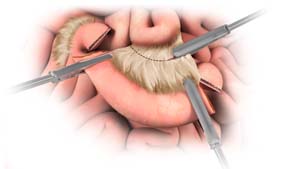Laparoscopic Small Bowel Resection
The small intestine or small bowel extends from your stomach to your large intestine and is where most of the digestion and absorption of nutrients from food occurs. Waste products formed in the small intestine are transported to the large intestine for excretion. Injury or disease may block or damage a section of bowel. This is treated by a procedure called small bowel resection, which involves cutting out the affected part of the small intestine.

Conditions that usually require small bowel resection include:
- Bleeding due to ulcers
- Blockage due to scar tissue or congenital abnormalities
- Infection
- Non-cancerous tumors
- Polyps that could turn cancerous
- Cancer
- Crohn’s disease (inflammatory disease of the intestine)
Small bowel resection is performed under general anesthesia as an open surgery or laparoscopic technique. Open surgery will require a single large incision, while the laparoscopic method is performed through small incisions through which a lighted tube and minute instruments are inserted. The affected part of the intestine is identified and isolated by clamping. The segment is then resected and the cut ends joined together (anastomosis). In cases where the bowel cannot be reconnected, an opening is created in the abdominal wall (stoma) through which the contents of the upper segment of small intestine pass out into a sealed bag (ileostomy). The ileostomy may be temporary to allow the bowel to heal or permanent depending on your condition.
The entire procedure takes about 1-4 hours to perform, following which you may have to stay in the hospital for 5-7 days or longer. During this time, you will receive nutrition through an intravenous line or a tube passing from your nose to your stomach. Clear fluids may be tolerated orally in 2-3 days, and food is gradually introduced.
As with any surgery, small bowel resection may carry certain risks such as bleeding, infection, diarrhea, problems with absorption of nutrients, scar tissue formation, incisional hernia (intestine pushes through the region of incision), leakage at joints or problems with the stoma.
